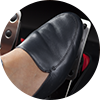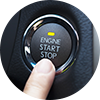You may not have control over the price of gas, but you can impact your consumption of it. The next time you hop in the car, consider these fuel efficiency tips to help save yourself an extra trip to the pump.
Take it Easy
 When you are hurried or frustrated with drivers, take a breath before you decide to zoom ahead only to break hard at stops. According to the Department of Energy, rapid acceleration and sudden braking can lower your gas mileage by 33% at highway speeds and by 5% on city streets. Is added gasoline cost worth the time you might save? Accelerate smoothly to a speed that can be maintained steadily without the need to slam breaks or take corners aggressively.
When you are hurried or frustrated with drivers, take a breath before you decide to zoom ahead only to break hard at stops. According to the Department of Energy, rapid acceleration and sudden braking can lower your gas mileage by 33% at highway speeds and by 5% on city streets. Is added gasoline cost worth the time you might save? Accelerate smoothly to a speed that can be maintained steadily without the need to slam breaks or take corners aggressively.
Slow Down
 When you break free from rush hour gridlock, it’s tempting to leave everyone in the dust. But for every 5 mph that you drive over 50 mph, your gallon per gas consumption goes up $0.25. Think how annoying it is when gas prices go up even a few cents! If you search for the cheapest gas, and then fly down the highway at top speed, you aren’t saving energy or money. When you can’t keep a steady speed, utilize cruise control to help save gas.
When you break free from rush hour gridlock, it’s tempting to leave everyone in the dust. But for every 5 mph that you drive over 50 mph, your gallon per gas consumption goes up $0.25. Think how annoying it is when gas prices go up even a few cents! If you search for the cheapest gas, and then fly down the highway at top speed, you aren’t saving energy or money. When you can’t keep a steady speed, utilize cruise control to help save gas.
Lose Weight
 A roof-top cargo box reduces fuel economy from wind resistance, but it packs on extra weight as well, which causes the vehicle to use more fuel. According to thefueleconomy.gov website, even leaving an empty box on your roof reduces fuel economy by around 2% to 8% in city driving, and up to 25% on the highway. Use rear-mount boxes or trays instead to get your fuel consumption down to 1-2%. And don’t forget about weight in your trunk or the vehicle itself.
A roof-top cargo box reduces fuel economy from wind resistance, but it packs on extra weight as well, which causes the vehicle to use more fuel. According to thefueleconomy.gov website, even leaving an empty box on your roof reduces fuel economy by around 2% to 8% in city driving, and up to 25% on the highway. Use rear-mount boxes or trays instead to get your fuel consumption down to 1-2%. And don’t forget about weight in your trunk or the vehicle itself.
Stay Cool
 When driving during short trips around town, you can economize fuel by driving with lowered windows. But when taking the long summer trip on the highway, it’s actually better to flip on the AC. Open windows will increase aerodynamic drag, which forces your car to work harder to move against wind at faster speeds. Air conditioning still adds to fuel inefficiency, so keep the temperature at the lowest setting that is comfortable for you.
When driving during short trips around town, you can economize fuel by driving with lowered windows. But when taking the long summer trip on the highway, it’s actually better to flip on the AC. Open windows will increase aerodynamic drag, which forces your car to work harder to move against wind at faster speeds. Air conditioning still adds to fuel inefficiency, so keep the temperature at the lowest setting that is comfortable for you.
Stop Your Engines
 Idling can use up to a half gallon of gas per hour, depending on engine size and AC use. These days, most cars do not need much time to warm up in cold weather (a minute or less), and you get zero miles per gallon when you leave it running in your driveway. When running errands, go to your furthest destination first, and your car will stay warmed up and use less fuel for the rest of your tasks.
Idling can use up to a half gallon of gas per hour, depending on engine size and AC use. These days, most cars do not need much time to warm up in cold weather (a minute or less), and you get zero miles per gallon when you leave it running in your driveway. When running errands, go to your furthest destination first, and your car will stay warmed up and use less fuel for the rest of your tasks.
The best way to reduce your vehicle’s fuel consumption may be to walk, bike or carpool, but when you are behind the wheel, these tips can help you get the most from your fuel budget.


 Electric cars obviously have a bigger positive impact on the environment because they have zero CO2 emissions, but they also have a lower driving range and a higher price tag. That said, in recent years the range has grown higher and the cost has come down, with even more of that promised from car manufacturers in the coming years. Electric cars also require less maintenance than hybrids, not to mention the fact that you’ll never have to pay for gas again. So, if you don’t have a long commute to work, an all-electric car might be a great option for you. An all-electric car is also perfect for two-car families: use the electric car for daily driving around town and a regular car or hybrid with a higher range for longer road trips.
Electric cars obviously have a bigger positive impact on the environment because they have zero CO2 emissions, but they also have a lower driving range and a higher price tag. That said, in recent years the range has grown higher and the cost has come down, with even more of that promised from car manufacturers in the coming years. Electric cars also require less maintenance than hybrids, not to mention the fact that you’ll never have to pay for gas again. So, if you don’t have a long commute to work, an all-electric car might be a great option for you. An all-electric car is also perfect for two-car families: use the electric car for daily driving around town and a regular car or hybrid with a higher range for longer road trips. The money-saving perks of driving an eco-friendly car go way beyond less money spent on gas. The current federal tax credit for a new all-electric car is $7,500. The federal tax credit for a new hybrid ranges from $2,500 to $7,500. Follow these links to see which electric and hybrid cars are eligible. Many states offer incentives as well, including cash rebates, carpool lane access and free municipal parking. You can even save money on your power or insurance bill if your provider offers a special rate for
The money-saving perks of driving an eco-friendly car go way beyond less money spent on gas. The current federal tax credit for a new all-electric car is $7,500. The federal tax credit for a new hybrid ranges from $2,500 to $7,500. Follow these links to see which electric and hybrid cars are eligible. Many states offer incentives as well, including cash rebates, carpool lane access and free municipal parking. You can even save money on your power or insurance bill if your provider offers a special rate for  You can still drive the next best thing. Each year, the Environmental Protection Agency awards SmartWay certifications to the top 20 percent of the cleanest, most efficient vehicles. You can search the EPA’s list of certified cars starting in the model year 2000 by
You can still drive the next best thing. Each year, the Environmental Protection Agency awards SmartWay certifications to the top 20 percent of the cleanest, most efficient vehicles. You can search the EPA’s list of certified cars starting in the model year 2000 by